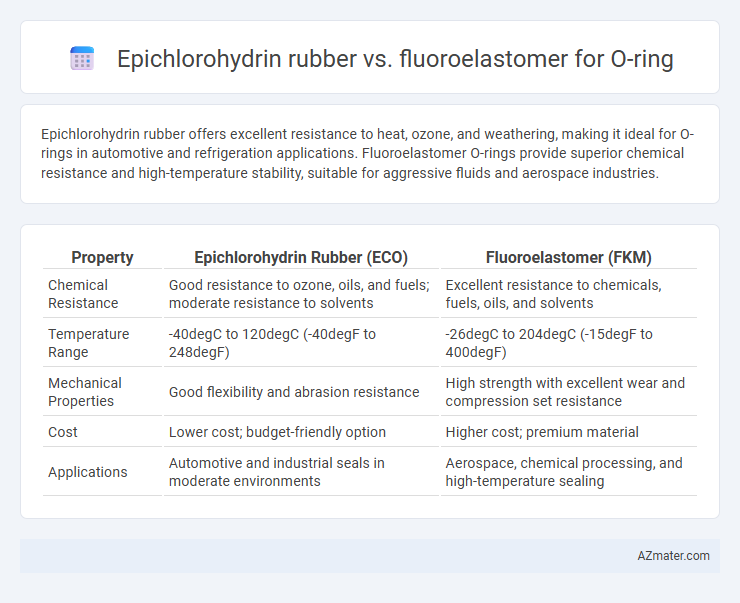Epichlorohydrin rubber offers excellent resistance to heat, ozone, and weathering, making it ideal for O-rings in automotive and refrigeration applications. Fluoroelastomer O-rings provide superior chemical resistance and high-temperature stability, suitable for aggressive fluids and aerospace industries.
Table of Comparison
| Property | Epichlorohydrin Rubber (ECO) | Fluoroelastomer (FKM) |
|---|---|---|
| Chemical Resistance | Good resistance to ozone, oils, and fuels; moderate resistance to solvents | Excellent resistance to chemicals, fuels, oils, and solvents |
| Temperature Range | -40degC to 120degC (-40degF to 248degF) | -26degC to 204degC (-15degF to 400degF) |
| Mechanical Properties | Good flexibility and abrasion resistance | High strength with excellent wear and compression set resistance |
| Cost | Lower cost; budget-friendly option | Higher cost; premium material |
| Applications | Automotive and industrial seals in moderate environments | Aerospace, chemical processing, and high-temperature sealing |
Introduction to Epichlorohydrin Rubber and Fluoroelastomer
Epichlorohydrin rubber (ECO) offers excellent ozone, heat, and chemical resistance, making it suitable for O-rings used in automotive and industrial applications involving oils, fuels, and hydraulic fluids. Fluoroelastomer (FKM) stands out for its superior thermal stability and exceptional resistance to aggressive chemicals, fuels, and solvents, making it ideal for high-performance sealing solutions in aerospace and chemical processing industries. Both materials provide durability and reliability, but FKM generally performs better under extreme temperature ranges and harsh chemical environments.
Chemical Composition and Structure Differences
Epichlorohydrin rubber (ECO) consists of alternating epichlorohydrin and ethylene oxide units, giving it excellent resistance to oils and ozone, with a relatively flexible saturated hydrocarbon backbone. Fluoroelastomers (FKM), composed of vinylidene fluoride and hexafluoropropylene, feature highly fluorinated carbon chains that provide exceptional chemical, heat, and fuel resistance due to their strong carbon-fluorine bonds. The structural difference results in ECO's superior low-temperature flexibility and oil resistance, while FKM offers unmatched resistance to harsh chemicals and high temperatures for O-ring applications.
Temperature Resistance Comparison
Epichlorohydrin rubber (ECO) O-rings exhibit reliable temperature resistance between -40degC and 120degC, making them suitable for moderate thermal applications. Fluoroelastomer (FKM) O-rings offer superior temperature resistance, typically ranging from -25degC up to 204degC or higher, ideal for high-heat environments. The enhanced thermal stability of fluoroelastomers supports longer service life under extreme temperatures compared to epichlorohydrin.
Chemical Compatibility and Fluid Resistance
Epichlorohydrin rubber exhibits excellent chemical compatibility with polar solvents, oils, and ozone, making it suitable for O-rings exposed to refrigerants, brake fluids, and weathering agents. Fluoroelastomers provide superior fluid resistance against aggressive chemicals such as fuels, hydrocarbons, and high-temperature oils, maintaining integrity in extreme environments. The choice between the two depends on specific application chemicals, with fluoroelastomers offering broader resistance to harsh chemicals while epichlorohydrin is preferred for aqueous and polar environments.
Mechanical Properties and Durability
Epichlorohydrin rubber offers excellent mechanical properties such as high tensile strength, moderate elongation, and superior resistance to ozone, weathering, and petroleum oils, making it suitable for O-rings in automotive and fuel system applications. Fluoroelastomers exhibit superior mechanical durability with outstanding heat resistance up to 200degC, exceptional chemical resistance against fuels, oils, and aggressive chemicals, and excellent compression set resistance, ideal for high-performance sealing environments. Both materials provide strong sealing capabilities, but fluoroelastomers outperform epichlorohydrin in long-term durability under extreme temperatures and aggressive chemical exposure.
Compression Set and Resilience
Epichlorohydrin rubber (ECO) exhibits excellent compression set resistance typically around 20-35%, maintaining seal integrity under prolonged stress and moderate temperatures. Fluoroelastomers (FKM) demonstrate superior compression set values often below 15%, with outstanding resilience against high temperatures and aggressive chemicals, enhancing longevity in harsh environments. When selecting O-rings, FKM's higher resilience and lower compression set make it ideal for demanding applications, whereas ECO provides cost-effective performance with good elasticity in moderate conditions.
Cost and Availability Factors
Epichlorohydrin rubber (ECO) offers a cost-effective solution for O-rings, priced significantly lower than fluoroelastomers such as Viton, making it suitable for budget-sensitive applications. Fluoroelastomers provide superior chemical resistance and temperature stability but face higher raw material costs and limited availability due to complex production processes. Availability of Epichlorohydrin rubber is generally more widespread, supported by established supply chains, whereas fluoroelastomers may experience supply constraints affecting lead times and pricing.
Typical Industry Applications
Epichlorohydrin rubber O-rings excel in automotive and refrigeration industries due to their superior resistance to weathering, ozone, and polar solvents, making them ideal for sealing in fuel systems and refrigerant lines. Fluoroelastomer O-rings are preferred in aerospace, chemical processing, and oil and gas sectors because of their exceptional chemical, heat, and fuel resistance, ensuring reliability in harsh environments involving aggressive chemicals and high temperatures. Industry applications often dictate the choice between Epichlorohydrin for moderate temperature and chemical resistance and Fluoroelastomer for extreme performance requirements.
Environmental and Safety Considerations
Epichlorohydrin rubber (ECO) offers strong resistance to oxygen and ozone, making it suitable for applications involving exposure to harsh weather but has a higher tendency to release hazardous byproducts such as epichlorohydrin monomer, which poses environmental and health risks. Fluoroelastomers (FKM) exhibit superior chemical resistance and thermal stability with lower toxicity, causing less environmental impact during use and disposal, and their inert nature reduces risks of hazardous emissions. Choosing FKM for O-rings is preferable when minimizing environmental hazards and ensuring safety in high-performance sealing applications is critical.
Selecting the Right Material for O-Ring Performance
Epichlorohydrin rubber offers excellent resistance to weathering, ozone, and petroleum oils, making it ideal for automotive and industrial sealing applications where moderate chemical resistance is required. Fluoroelastomers provide superior chemical, heat, and fuel resistance, excelling in aerospace, chemical processing, and high-temperature environments. Selecting the right O-ring material depends on the specific application requirements such as temperature range, chemical exposure, and mechanical stress, with fluoroelastomers preferred for harsh conditions and epichlorohydrin rubber suited for moderate, oil-focused environments.

Infographic: Epichlorohydrin rubber vs Fluoroelastomer for O-ring
 azmater.com
azmater.com